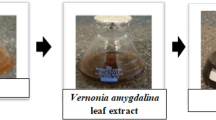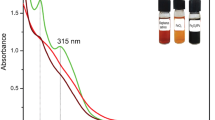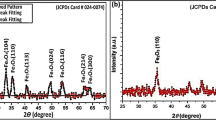Abstract
In this study, rapid decolorization of azo dyes was achieved by in situ-generated green tea extract-iron (GTE-Fe) chelate for the first time. When changing reaction conditions from the aerobic condition to the anaerobic condition, the decolorization efficiencies of two azo dyes, i.e., acid orange 7 (AO7) and acid black 1 (AB1), increased from 46.38 and 83.17 to 90.13 and 95.37%, respectively. The recalcitrant AO7 was then selected as the targeting pollutant in subsequent optimization and mechanism studies. Experimental evidences showed that the initial concentrations of AO7, Fe(III), and GTE are the key factors to optimize the decolorization efficiency. Further characterization studies by spectroscopic analysis, including FESEM, FTIR, and XPS, suggested that the major mechanism of AO7 decolorization is the nucleophilic attack of the oxygen in green tea polyphenols (GTP), and this attack could be facilitated by the organometal chelation. This study provided an efficient and environmental friendly strategy to decolorize azo dyes via in situ generation of the GTE-Fe chelate, as well as its mechanistic insights, shedding lights on in situ remediation of azo dye pollution.

ᅟ








Similar content being viewed by others
References
Aboulhassan MA, Souabi S, Yaacoubi A, Baudu M (2006) Improvement of paint effluents coagulation using natural and synthetic coagulant aids. J Hazard Mater 138:40–45
Akhavan O, Kalaee M, Alavi ZS, Ghiasi SMA, Esfandiar A (2012) Increasing the antioxidant activity of green tea polyphenols in the presence of iron for the reduction of graphene oxide. Carbon 50:3015–3025
Alam MZ, Mansor MF, Jalal KC (2009) Optimization of decolorization of methylene blue by lignin peroxidase enzyme produced from sewage sludge with Phanerocheate chrysosporium. J Hazard Mater 162:708–715
Amjad Ali K, Qayyum H (2007) Potential of plant polyphenol oxidases in the decolorization and removal of textile and non-textile dyes. J Environ Sci 19:396–402
Andjelković M, Van Camp J, De Meulenaer B, Depaemelaere G, Socaciu C, Verloo M, Verhe R (2006) Iron-chelation properties of phenolic acids bearing catechol and galloyl groups. Food Chem 98:23–31
Barreto-Rodrigues M, Silveira J, Zazo JA, Rodriguez JJ (2016) Synthesis, characterization and application of nanoscale zero-valent iron in the degradation of the azo dye Disperse Red 1. J. Environ. Chem Eng 5:628–634
Barth G, Linder R, Bryson C (1988) Advances in charge neutralization for XPS measurements of nonconducting materials. Surf Interface Anal 11:307–311
Beamson G, Briggs D (1992) High resolution XPS of organic polymers. Wiley
Biesinger MC, Payne BP, Grosvenor AP, Lau LW, Gerson AR, Smart RSC (2011) Resolving surface chemical states in XPS analysis of first row transition metals, oxides and hydroxides: Cr, Mn, Fe, Co and Ni. Appl Surf Sci 257:2717–2730
Blomquist J, Helgeson U, Moberg LC, Folkesson B, Larsson R (1983) ESCA and Mössbauer spectra of some iron (III) betadiketonates and tetraphenylporphyrin iron (III) chloride. Inorg Chim Acta 69:17–23
Cheng X, Jia R, Li P, Tu S, Zhu Q, Tang W, Li X (2007) Purification of a new manganese peroxidase of the white-rot fungus Schizophyllum sp. F17, and decolorization of azo dyes by the enzyme. Enzyme Microb Tech 41:258–264
Chrysochoou M, Johnston CP, Dahal G (2012) A comparative evaluation of hexavalent chromium treatment in contaminated soil by calcium polysulfide and green-tea nanoscale zero-valent iron. J Hazard Mater 201–202:33–42
Cui M-H, Cui D, Gao L, Wang A-J, Cheng H-Y (2016a) Azo dye decolorization in an up-flow bioelectrochemical reactor with domestic wastewater as a cost-effective yet highly efficient electron donor source. Water Res 105:520–526
Cui MH, Cui D, Hyung-Sool L, Liang B, Wang AJ, Cheng HY (2016b) Effect of electrode position on azo dye removal in an up-flow hybrid anaerobic digestion reactor with built-in bioelectrochemical system. Sci Rep 6:25223
Elmorsi TM, Riyad YM, Mohamed ZH, Hm AEB (2010) Decolorization of Mordant red 73 azo dye in water using H2O2/UV and photo-Fenton treatment. J Hazard Mater 174:352–358
Fang Z, Song HL, Cang N, Li XN (2013) Performance of microbial fuel cell coupled constructed wetland system for decolorization of azo dye and bioelectricity generation. Bioresour Technol 144:165–171
Fu Y, Viraraghavan T (2001) Fungal decolorization of dye wastewaters: a review. Bioresour Technol 79:251–262
Graham HN (1992) Green tea composition, consumption, and polyphenol chemistry. Prev Med 21:334–350
Grinberg LN, Newmark H, Kitrossky N, Rahamim E, Chevion M, Rachmilewitz EA (1997) Protective effects of tea polyphenols against oxidative damage to red blood cells. Biochem Pharmacol 54:973–978
GS N JG, GM G RZ, J R WS (2002) Decolorization of textile dyes by laccases from a newly isolated strain of Trametes modesta. Water Res 36:1449–1456
Hadibarata T, Yusoff ARM, Kristanti RA (2012) Decolorization and metabolism of anthraquionone-type dye by laccase of white-rot fungi Polyporus sp. S133. Water Air Soil Poll 223:933–941
Hajji HE, Nkhili E, Tomao V, Dangles O (2006) Interactions of quercetin with iron and copper ions: complexation and autoxidation. Free Radic Res 40:303–320
Hider RC, Liu ZD, Khodr HH (2001) Metal chelation of polyphenols, Methods Enzymol Elsevier, pp. 190–203
Hoag GE, Collins JB, Holcomb JL, Hoag JR, Nadagouda MN, Varma RS (2009) Degradation of bromothymol blue by ‘greener’ nano-scale zero-valent iron synthesized using tea polyphenols. J Mater Chem 19:8671–8677
Huang L, Weng X, Chen Z, Megharaj M, Naidu R (2014) Green synthesis of iron nanoparticles by various tea extracts: comparative study of the reactivity. Spectrochim Acta A 130:295–301
Imran M, Arshad M, Negm F, Khalid A, Shaharoona B, Hussain S, Mahmood Nadeem S, Crowley DE (2016) Yeast extract promotes decolorization of azo dyes by stimulating azoreductase activity in Shewanella sp. strain IFN4. Ecotox Environ Safe 124:42–49
Khan R, Bhawana P, Fulekar MH (2013) Microbial decolorization and degradation of synthetic dyes: a review. Rev Environ Sci Bio 12:75–97
Khan A, Prabhu SM, Park J, Lee W, Chon C-M, Ahn JS, Lee G (2017) Azo dye decolorization by ZVI under circum-neutral pH conditions and the characterization of ZVI corrosion products. J Ind Eng Chem 47:86–93
Klimczak I, Malecka M, Szlachta M, Gliszczynskaswiglo A (2007) Effect of storage on the content of polyphenols, vitamin C and the antioxidant activity of orange juices. J Food Compos Anal 20:313–322
Lee YH, Pavlostathis SG (2004) Decolorization and toxicity of reactive anthraquinone textile dyes under methanogenic conditions. Water Res 38:1838–1852
Li HX, Xu B, Tang L, Zhang JH, Mao ZG (2015) Reductive decolorization of indigo carmine dye with Bacillus sp. MZS10. Int Biodeter Biodegr 103:30–37
Lu Y, Foo LY (2001) Antioxidant activities of polyphenols from sage (Salvia officinalis). Food Chem 75:197–202
Markova Z, Novak P, Kaslik J, Plachtova P, Brazdova M, Jancula D, Siskova KM, Machala L, Marsalek B, Zboril R (2014) Iron(II,III)–polyphenol complex nanoparticles derived from green tea with remarkable ecotoxicological impact. ACS Sustain Chem Eng 2:1674–1680
Melidou M, Riganakos K, Galaris D (2005) Protection against nuclear DNA damage offered by flavonoids in cells exposed to hydrogen peroxide: the role of iron chelation. Free Radical Bio Med 39:1591–1600
Mijin DŽ, Ivić MLA, Onjia AE, Grgur BN (2012) Decolorization of textile dye CI Basic Yellow 28 with electrochemically generated active chlorine. Chem Eng J 204–206:151–157
Moulton MC, Braydich-Stolle LK, Nadagouda MN, Kunzelman S, Hussain SM, Varma RS (2010) Synthesis, characterization and biocompatibility of “green” synthesized silver nanoparticles using tea polyphenols. Nano 2:763–770
Murugesan K, Kim Y-M, Jeon J-R, Chang Y-S (2009) Effect of metal ions on reactive dye decolorization by laccase from Ganoderma lucidum. J Hazard Mater 168:523–529
Nanjo F, Goto K, Seto R, Suzuki M, Sakai M, Hara Y (1996) Scavenging effects of tea catechins and their derivatives on 1,1-diphenyl-2-picrylhydrazyl radical. Free Radical Bio. Med. 21:895–902
Nune S, Chanda N, Shukla R, Katti K, Kulkarni R, Thilakavathy S, Mekapothula S, Kannan R (2009) Green nanotechnology from tea: phytochemicals in tea as building blocks for production of biocompatible gold nanoparticles. J Mater Chem 19:2912–2920
Oztürk A, Abdullah MI (2006) Toxicological effect of indole and its azo dye derivatives on some microorganisms under aerobic conditions. Sci Total Environ 358:137–142
Pagga U, Brown D (1986) The degradation of dyestuffs: part II behaviour of dyestuffs in aerobic biodegradation tests. Chemosphere 15:479–491
Pan K, Zhao N, Yin Q, Zhang T, Xu X, Fang W, Hong Y, Fang Z, Xiao Y (2014) Induction of a laccase Lcc9 from Coprinopsis cinerea by fungal coculture and its application on indigo dye decolorization. Bioresour Technol 162:45–52
Perron NR, Brumaghim JL (2009) A review of the antioxidant mechanisms of polyphenol compounds related to iron binding. Cell Biochem Biophys 53:75–100
Rathod J, Dhebar S, Archana G (2017) Efficient approach to enhance whole cell azo dye decolorization by heterologous overexpression of Enterococcus sp. L2 azoreductase (azoA) and Mycobacterium vaccae formate dehydrogenase (fdh) in different bacterial systems. Int Biodeter Biodegr. Int. Biodeter. Biodegr 124:91–100
Rawat D, Mishra V, Sharma RS (2016) Detoxification of azo dyes in the context of environmental processes. Chemosphere 155:591–605
Salah N, Miller NJ, Paganga G, Tijburg L, Bolwell GP, Rice-Evans C (1995) Polyphenolic flavanols as scavengers of aqueous phase radicals and as chain-breaking antioxidants. Arch Biochem Biophys 322:339–346
Santal AR, Singh NP, Saharan BS (2011) Biodegradation and detoxification of melanoidin from distillery effluent using an aerobic bacterial strain SAG 5 of Alcaligenes faecalis. J Hazard Mater 193:319–324
Serafini M, Ghiselli A, Ferroluzzi A (1996) In vivo antioxidant effect of green and black tea in man. Eur J Clin Nutr 50:28
Sharma S, Buddhdev J, Patel M, Ruparelia JP (2013) Studies on degradation of reactive red 135 dye in wastewater using ozone. Procedia Eng 51:451–455
Srivastava S, Badrinarayanan S, Mukhedkar A (1985) X-ray photoelectron spectra of metal complexes of substituted 2, 4-pentanediones. Polyhedron 4:409–414
Stolz A (2001) Basic and applied aspects in the microbial degradation of azo dyes. Appl Microbiol Biot 56:69–80
Tan BJ, Klabunde KJ, Sherwood PM (1990) X-ray photoelectron spectroscopy studies of solvated metal atom dispersed catalysts. Monometallic iron and bimetallic iron-cobalt particles on alumina. Chem Mater 2:186–191
Vinodgopal K, Wynkoop DE, Kamat PV (1996) Environmental photochemistry on semiconductor surfaces: photosensitized degradation of a textile azo dye, Acid Orange 7, on TiO2 particles using visible light. Environ Sci Technol 30:1660–1666
Wang Z, Fang C, Mallavarapu M (2015) Characterization of iron–polyphenol complex nanoparticles synthesized by Sage (Salvia officinalis) leaves. Environ Technol Innov 4:92–97
Weng X, Huang L, Chen Z, Megharaj M, Naidu R (2013) Synthesis of iron-based nanoparticles by green tea extract and their degradation of malachite. Ind Crop Prod 51:342–347
Wilson D, Langell MA (2014) XPS analysis of oleylamine/oleic acid capped Fe3O4 nanoparticles as a function of temperature. Appl Surf Sci 303:6–13
Zaveri NT (2006) Green tea and its polyphenolic catechins: medicinal uses in cancer and noncancer applications. Life Sci 78:2073–2080
Zhang S-J, Yu H-Q, Li Q-R (2005) Radiolytic degradation of Acid Orange 7: a mechanistic study. Chemosphere 61:1003–1011
Acknowledgements
This study was supported by the Guangzhou Science and Technology Program general project (201804010141).
Author information
Authors and Affiliations
Corresponding author
Additional information
Responsible editor: Bingcai Pan
Electronic supplementary material
ESM 1
(DOCX 150 kb)
Rights and permissions
About this article
Cite this article
Yu, L., Qiu, Y., Yu, Y. et al. Reductive decolorization of azo dyes via in situ generation of green tea extract-iron chelate. Environ Sci Pollut Res 25, 17300–17309 (2018). https://doi.org/10.1007/s11356-018-1907-4
Received:
Accepted:
Published:
Issue Date:
DOI: https://doi.org/10.1007/s11356-018-1907-4




